Galerius
| Galerius | |||||||||
|---|---|---|---|---|---|---|---|---|---|
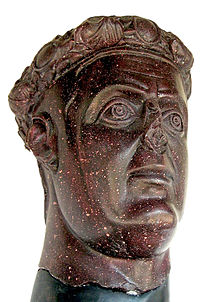 | |||||||||
| Roman emperor | |||||||||
| Augustus | 1 May 305 – early May 311 | ||||||||
| Predecessor | DiocletianandMaximian | ||||||||
| Successor | Maximinus IIandLicinius (both in the East) | ||||||||
| Co-rulers | See list
| ||||||||
| Caesar | 1 March 293[i]– 1 May 305 (underDiocletian)[3] | ||||||||
| Born | Galerius Maximinus[4][5] c.258[6][7] Felix Romuliana,Roman Dacia,Roman Empire[7] | ||||||||
| Died | early May 311[8](aged c. 53) Serdica,Dacia Ripensis,Roman Empire | ||||||||
| Burial | |||||||||
| Spouse | Galeria Valeria[9] | ||||||||
| Issue | |||||||||
| |||||||||
| Father | Diocletian(adoptive) | ||||||||
| Mother | Romula (alleged)[10] | ||||||||
| Religion | Roman polytheism | ||||||||
Galerius Valerius Maximianus[j](/ɡəˈlɛəriəs/;Greek:Γαλέριος;c.258 – May 311) wasRoman emperorfrom 305 to 311. During his reign he campaigned, aided byDiocletian,against theSasanian Empire,sacking their capitalCtesiphonin 299. He also campaigned across theDanubeagainst theCarpi,defeating them in 297 and 300. Although he was a staunch opponent ofChristianity,Galerius ended theDiocletianic Persecutionwhen he issued theEdict of TolerationinSerdica(Sofia) in 311.
Early life[edit]
Galerius was born nearSerdica,[13]inDacia Ripensis,later named Dacia Mediterranea, though some modern scholars consider the strategic site where he later built his palace named after his mother –Felix Romuliana(Gamzigrad) – his birth and funeral place.[7]HisThracianfather and his mother, Romula, had leftRoman Dacia(todayRomania) because of theCarpians' attacks.[14][15]: 19 He originally followed his father's occupation, that of a herdsman, where he was nicknamed "Armentarius", herdsman (Latin:armentum,lit. 'herd').[16]His originalcognomenwas "Maximinus", but he changed it to "Maximianus" after becomingCaesar.[4]
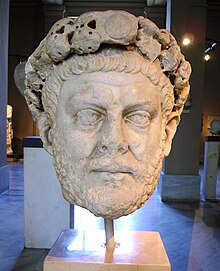
He served with distinction as a soldier under EmperorsAurelianandProbus,and in 293, at the establishment of theTetrarchy,was designatedCaesaralong withConstantius Chlorus,receiving in marriageDiocletian's daughter Valeria (later known asGaleria Valeria), and at the same time being entrusted with the care of theIllyrianprovinces. After a few years campaigning againstSarmatiansandGothson theDanube,he received command of the legions on the eastern imperial limits. Soon after his appointment, Galerius was dispatched to Egypt to fight the rebellious citiesBusirisandCoptos.[17]
War with Persia[edit]
Invasion, counterinvasion[edit]
In 294,Narseh,a son ofShapur I,who had been passed over for the Sassanid succession, came into power in Persia. Narseh probably moved to eliminateBahram III,a young man installed by a noble named Vahunam in the wake of Bahram II's death in 293.[18][19]: 69 In early 294, Narseh sent Diocletian the customary package of gifts, but within Persia, he was destroying every trace of his immediate predecessors, erasing their names from public monuments. He sought to identify himself with the warlike reigns ofArdashir(r. 226–241) andShapur(r. 241–272), who had sacked Roman Antioch and captured EmperorValerian.[19]: 69–70
In 295 or 296, Narseh declared war on Rome. He appears to have first invaded western Armenia, retaking the lands delivered to Tiridates in the peace of 287. He occupied the lands there until the following year.[18][20][21][22]The historian Ammianus Marcellinus, circa 320–395, is the only source detailing the initial invasion of Armenia.[23]Southern (1999, 149) dates the invasion to 295; Barnes (1982, 17, 293) mentions an earlier, unsuccessful invasion by Narseh based on the fact that the titlePersici Maximiwas given to all four emperors; Odahl (2004, 59) concurs with Barnes and suggests that Saracen princes in the Syrian desert collaborated with Narseh's invasion. Narseh then moved south into Roman Mesopotamia, where he inflicteda severe defeaton Galerius, then commander of the eastern forces, in the region between Carrhae (Harran,Turkey) and Callinicum (Raqqa,Syria).[21]Diocletian may or may not have been present at the battle,[24]but presented himself soon afterwards at Antioch, issuing an official version of events which placed all the blame for the affair upon Galerius. In Antioch, Diocletian forced Galerius to walk a mile in advance of his imperial cart while still clad in the purple robes of an emperor.[25][21]David Stone Potterreads a symbolic message in the display: the loss at Carrhae was due not to the failings of the empire's soldiers, but to the failings of their commander, and Galerius' failures would not be accepted.[26]Another scholar, Roger Rees, suggests that Galerius' position at the head of the caravan was merely the conventional organization of an imperial progression, designed to show aCaesar's deference to hisAugustus.[27]
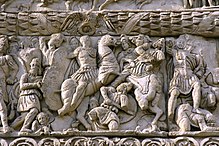
Galerius's army was reinforced probably in the spring of 298 by new contingents collected from the empire's Danubian holdings.[29]Narseh did not advance from Armenia and Mesopotamia leaving Galerius to lead the offensive in 298 with an attack on northern Mesopotamia via Armenia.[26]Diocletian may or may not have been present to assist the campaign.[30]Narseh retreated to Armenia to fight Galerius' force, putting himself at a disadvantage; the rugged Armenian terrain was favorable to Roman infantry, but not to Sassanid cavalry. Local aid gave Galerius the advantage of surprise over the Persian forces, and he defeated Narseh in two successive battles.[26][29]During the second encounter, theBattle of Satalain 298, Roman forces seized Narseh's camp, his treasury, his harem, and his wife.[26][29]Narseh's wife would live out the remainder of the war in Daphne, a suburb of Antioch, serving as a constant reminder to the Persians of the Roman victory.[26]
Galerius advanced intoMediaandAdiabene,winning continuous victories, most prominently nearTheodosiopolis(Erzurum),[28]and securingNisibis(Nusaybin) before 1 October 298. He moved down theTigris,takingCtesiphon,and gazing onwards to the ruins ofBabylonbefore returning to Roman territory via theEuphrates.[29]No source ever specifically claims that Ctesiphon was sacked, but it is assumed to have been, primarily due to the seizure of Narseh's wife and harem.[31]
Peace negotiations[edit]
Narseh had previously sent an ambassador to Galerius to plead for the return of his wife and children, but Galerius had dismissed this ambassador, reminding him of how Shapur had treated Valerian.[29]In any case, the Romans treated Narseh's captured family well, perhaps seeking to evoke comparisons toAlexanderand his beneficent conduct towards the family ofDarius III.[26]Peace negotiations began in the spring of 299, with both Diocletian and Galerius presiding. Theirmagister memoriae(secretary) Sicorius Probus was sent to Narseh to present terms.[29]
The conditions of thePeace of Nisibiswere heavy:[26]Persia would give up territory to Rome, making the Tigris the boundary between the two empires. Further terms specified that Armenia was returned to Roman domination with the fort of Ziatha as its border;Caucasian Iberiawould pay allegiance to Rome under a Roman appointee; Nisibis, now under Roman rule, would become the sole conduit for trade between Persia and Rome; and Rome would exercise control over the five satrapies between the Tigris and Armenia:Ingilene,Sophanene (Sophene), Arzanene (Aghdznik),Corduene,andZabdicene(near modernHakkâri,Turkey). These regions included the passage of the Tigris through theAnti-Taurusrange; theBitlispass, the quickest southerly route into Persian Armenia; and access to theTur Abdinplateau. With these territories, Rome would have an advance station north of Ctesiphon, and would be able to slow any future advance of Persian forces through the region.[32]Under the terms of the peace, Tiridates would regain both his throne and the entirety of his ancestral claim, and Rome would secure a wide zone of cultural influence in the region.[29]Because the empire was able to sustain such constant warfare on so many fronts, it has been taken as a sign of the essential efficacy of the Diocletianic system and the goodwill of the army towards the tetrarchic enterprise.[31]
Rule as Augustus[edit]

After the abdication ofDiocletianin 305 and the elevation ofConstantius Iand Galerius to the rank ofAugustus,two newCaesars were required to take their place. The two persons whom Galerius promoted to the rank ofCaesarwere very much his creatures, and he hoped to enhance his authority throughout the empire with their elevation.[34]
First wasMaximinus Daza,whose mother was Galerius' sister. An inexperienced youth with little formal education, he was invested with the purple, exalted to the dignity ofCaesar,and assigned the command of Egypt and Syria. Second wasSeverus,Galerius' comrade in arms; he was sent toMediolanumto receive the possession of Italy and Africa. According to the forms of the constitution, Severus acknowledged the supremacy of the western emperor, but he was absolutely devoted to the commands of his benefactor Galerius, who, reserving to himself the intermediate countries from the confines of Italy to those of Syria, firmly established his power over three-quarters of the empire.[34]
His hopes were dashed when his colleague Constantius died atYorkin 306 and the legions elevated his sonConstantineto the position ofAugustus.Galerius only discovered this when he received a letter from Constantine, who informed him of his father's death, modestly asserted his natural claim to the succession, and respectfully lamented that the enthusiastic violence of his troops had not allowed him to obtain the imperial purple in the regular and constitutional manner. The first emotions of Galerius were those of surprise, disappointment, and rage, and as he could seldom restrain his passions, he threatened to burn both the letter and the messenger.[35][36][37][38]
Later, however, when he had time to reconsider his position, he inevitably saw that his chances of winning a war against Constantine were doubtful at best. Galerius was well aware of Constantine's strengths – Constantine had been his guest for some time atNicomedia– and knew that Constantius' legions were wildly devoted to his son.[34]Therefore, without either condemning or ratifying the choice of theRoman army,Galerius accepted the son of his deceased colleague as the ruler of the provinces beyond the Alps; but he gave him only the title ofCaesar,and the fourth rank among the Roman princes, whilst he conferred the vacant place ofAugustuson his favourite Severus.

The ambitious spirit of Galerius was only just over this disappointment when he beheld the unexpected loss of Italy toMaxentius,who was married to his daughterValeria Maximilla.[39]Galerius' need for additional revenue had persuaded him to make a very strict and rigorous examination of the property of his subjects for the purpose of a general taxation. A very minute survey was taken of their real estates and, wherever there was the slightest suspicion of concealment, torture was used to obtain a sincere declaration of their personal wealth. Italy had traditionally been exempt from any form of taxation, but Galerius ignored this precedent, and the officers of the revenue already began to number the Roman people, and to settle the proportion of the new taxes. Italy began to murmur against this indignity and Maxentius used this sentiment to declare himself emperor in Italy, to the fury of Galerius. Therefore, Galerius ordered his colleague Severus to immediately march to Rome, in the full confidence that, by his unexpected arrival, he would easily suppress the rebellion.[34]Severus was captured after his troops deserted to their old commanderMaximian,who had once again been elevated to the rank of co-emperor, this time by his son Maxentius. Severus was later executed.
The importance of the occasion needed the presence and abilities of Galerius. At the head of a powerful army collected fromIllyricumand the East, he entered Italy, determined to avenge Severus and to punish the rebellious Romans. But due to the skill of Maximian, Galerius found every place hostile, fortified, and inaccessible; and though he forced his way as far asNarni,within sixty miles of Rome, his control in Italy was confined to the narrow limits of his camp.

Seeing that he was facing ever-greater difficulties, Galerius made the first advances towards reconciliation, and dispatched two officers to tempt the Romans by the offer of a conference, and the declaration of his paternal regard for Maxentius, reminding them that they would obtain much more from his willing generosity than anything that might have been obtained through a military campaign. The offers of Galerius were rejected with firmness, his friendship refused, and it was not long before he discovered that, unless he retreated, he would share Severus' fate. It was not a moment too soon; large monetary gifts from Maxentius to his soldiers had corrupted the fidelity of the Illyrian legions. When Galerius finally began his withdrawal from Italy, it was only with great difficulty that he managed to stop his veterans deserting him.[34]In frustration, Galerius allowed his legions to ravage the countryside as they passed northwards. Maxentius declined to make a general engagement.
With so many emperors now in existence, in 308 Galerius, together with the retired emperor Diocletian and the now active Maximian, called an imperial 'conference' atCarnuntumon the River Danube to rectify the situation and bring some order back into the imperial government. Here it was agreed that Galerius' long-time friend and military companionLicinius,who had been entrusted by Galerius with the defense of the Danube while Galerius was in Italy, would becomeAugustusin the West, with Constantine as hisCaesar.In the East, Galerius remainedAugustusand Maximinus remained hisCaesar.Maximian was to retire, and Maxentius was declared a usurper.
Galerius' plan soon failed. The news of Licinius' promotion was no sooner carried into the East, than Maximinus, who governed the provinces of Egypt and Syria, rejected his position asCaesarand, notwithstanding the prayers as well as arguments of Galerius, exacted the equal title ofAugustus.[34]Around the same time,Maximianproclaimed himself emperor inArlesin opposition to Constantine, who was campaigning against theFranks.For the first, and indeed for the last time, seven emperors administered the Roman world: Galerius (East),Maximinus II(East),Licinius(Middle),Constantine I(West),Maximian(West),Maxentius(Italy), andDomitius Alexander(Africa).
The last years of Galerius saw him relinquishing his aspirations towards being the supreme ruler of the empire, though he managed to retain the position of first among equals. He spent the remainder of his years enjoying himself and ordering some important public works, such as discharging into theDanubethe superfluous waters of Lake Pelso (nowLake Balaton), and cutting down the immense forests that encompassed it.[34]
Persecution of Christians[edit]
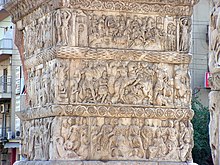
Christians had lived pleasantly during most of the rule of Diocletian. The persecutions that began with an edict of 24 February 303, were credited by Christians to Galerius' work, as he was a fierce advocate of the old ways and old gods. Christian houses of assembly were destroyed, for fear of sedition in secret gatherings.Diocletianwas not anti-Christian during the first part of his reign, and historians have claimed that Galerius decided to prod him into persecuting them by secretly burning the Imperial Palace and blaming it on Christian saboteurs. Regardless of who was at fault for the fire, Diocletian's rage was aroused and he began one of the last and greatest Christian persecutions in the history of theRoman Empire.[citation needed]
It was at the insistence of Galerius that the last edicts of persecution against theChristianswere published, beginning in 303, and this policy of repression was maintained by him until the appearance of the general edict of toleration, issued inSerdica[40][41][42]in April 311, apparently during his last bout of illness (seeEdict of Toleration by Galerius). Galerius's last request was that Christians should pray for him as he suffered with a painful and fatal illness.[43]
Initially one of the leading figures in the persecutions, Galerius later admitted that the policy of trying to eradicate Christianity had failed, saying: "wherefore, for this our indulgence, they ought to pray to their God for our safety, for that of the republic, and for their own, that the republic may continue uninjured on every side, and that they may be able to live securely in their homes."Lactantiusgives the text of the edict in his moralized chronicle of the bad ends to which all the persecutors came,De Mortibus Persecutorum.[44]This marked the end of official persecution of Christians, which was officially legalized two years later by Constantine andLiciniusin theEdict of Milan.
Death[edit]
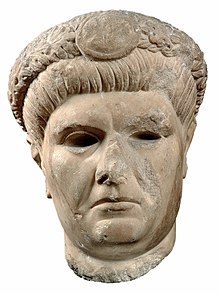
Galerius died in late April or early May 311[47]from a horribly gruesome disease described byEusebius[48]andLactantius,[49]possibly some form ofbowel cancer,gangreneorFournier gangrene.
Galerius was buried in hismausoleumatGamzigrad-Romuliana,which was part of the palace he built at his birthplace, today'sZaječarinSerbia.Several lumps composed of corroded iron ring mail (lorica hamata) have been found at the site. This mail armour may have been worn by the wax figure of the emperor that was burned during the imperial funeral andapotheosisceremony.[50]The entire site has been inscribed into theWorld Heritage Listin June 2007.
Anti-Roman accusations[edit]
According toLactantius,a Christian and adviser to Constantine, Galerius affirmed his Dacian identity and avowed himself the enemy of the Roman name once made emperor, even proposing that the empire should be called, not the Roman, but the Dacian Empire, much to the horror of the patricians and senators. Lactantius further states that Galerius exhibited anti-Roman attitude as soon as he had attained the highest power, treating the Roman citizens with ruthless cruelty, like the conquerors treated the conquered, all in the name of the same treatment that the victoriousTrajanhad applied to theconquered Dacians,forefathers of Galerius, two centuries before.[51]
Honours[edit]
Galerius PeakinAntarcticais named after Emperor Galerius.[52]
Family tree[edit]
|
(See also:Chronological scheme of the Tetrarchy, 286–324)
| |||||||||||||||||||||||||||||||||||||||||||||||||||||||||||||||||||||||||||||||||||||||||||||||||||||||||||||||||||||||||||||||||||||||||||||||||||||||||||||||||||||||||||||||||||||||||||||||||||||||||||||||||||||||||||||||||||||||||||||||||||||||||||||||||||||||||||||||||||||||||||||||||||||||||||||||||||||||||||||||||||||||||||||||||||||||||||||||||||||||||||||||||||||||||||||||||||||||||||||||||||||||||||||||||||||||||||||||||||||||||||||||||||||||||||||||||||||||||||||||||||||||||||||||||||||||||||||||||||||||||||||||||||||||||||||||||||||||||||||||||||||||||||||||||||||||||||||||||||||||||||||||||||||||||||||||||||||||||||||||||||||||||||||||||||||||||||
|
Notes:
Bibliography:
| |||||||||||||||||||||||||||||||||||||||||||||||||||||||||||||||||||||||||||||||||||||||||||||||||||||||||||||||||||||||||||||||||||||||||||||||||||||||||||||||||||||||||||||||||||||||||||||||||||||||||||||||||||||||||||||||||||||||||||||||||||||||||||||||||||||||||||||||||||||||||||||||||||||||||||||||||||||||||||||||||||||||||||||||||||||||||||||||||||||||||||||||||||||||||||||||||||||||||||||||||||||||||||||||||||||||||||||||||||||||||||||||||||||||||||||||||||||||||||||||||||||||||||||||||||||||||||||||||||||||||||||||||||||||||||||||||||||||||||||||||||||||||||||||||||||||||||||||||||||||||||||||||||||||||||||||||||||||||||||||||||||||||||||||||||||||||||
See also[edit]
Notes[edit]
- ^In the West; proclaimed by Maximian.
- ^In the West; proclaimed by Galerius.
- ^In the West; not recognized by the other tetrarchs.
- ^In Italy; not recognized by the other tetrarchs.
- ^In Italy; not recognized by the other tetrarchs. He was defeated in 308, but rebelled again in 310.
- ^In the Middle realms; proclaimed by Galerius. Emperor of the East following Maximinus' death.
- ^Usurper in Africa, unrecognized elsewhere.
- ^In the East; proclaimed by his troops.
- ^The earlier dates for Galerius' appointment have been argued for based on the suggestion that the appointments of Constantius and Galerius were timed to coincide (Barnes 1981, 8–9; Southern 1999, 146). Barnes (1982, 62) argues against a dating of 21 May 293 in Nicomedia originating in Seston,Dioclétien,88ff., stating that the evidence adduced (the 7th-centuryPaschal ChronicleOl.268and the contemporaryLactantius,DMP19.2) is invalid and confused. Lactantius is commenting on Diocletian and the place where Diocletian was acclaimed, and that the "Maximianus" in the text is therefore a later gloss; the Paschal Chronicle is not authoritative for this period for events outside Egypt, and may simply be commenting on the day when the laureled image of the new emperors arrived in Alexandria. Moreover, Lactantius (DMP35) explicitly states that Galerius'dies imperiifell on 1 March. Potter (2004, 650) agrees that locating the acclamation to Nicomedia is false, but believes that Seston's other evidence makes a strong case for a temporal lag between the two Caesars' acclamations.
- ^Sometimes called "Maximian II",[11][12] since ancient sources often call him "Galerius Maximianus".
- ^EmperorMaximianapparently never issued any coinage when he wasCaesar,so coins with the name "Maximianus Caesar" must represent Galerius. The only source that refers to Maximian as having beenCaesarisEutropius.[33]
References[edit]
- ^http://laststatues.classics.ox.ac.uk, LSA-845 (Marianne Bergmann)
- ^Elsner, Jas(2018).The Art of the Roman Empire AD 100–450.Oxford University Press.p. 58.ISBN9780198768630.
A recently discovered porphyry head of a tetrarch from Romuliana in modern Serbia—the birth and burial place of Galerius (293–311) [...] It is likely that the statue portrays Galerius as Caesar after his victory over the Persians in AD 297/8.
- ^abBarnes 1982,p. 4.
- ^abLactantius,de Mortibus Persecutorum,18. "Now Galerius had lately bestowed part of his own name on that youth [Daia], and called him Maximin, in like manner as Diocletian formerly bestowed on Galerius the name of Maximian".
- ^For an analysis of the official nomenclature of the Tetrarchs, seeSalway, Benet(1994)."What's in a Name? A Survey of Roman Onomastic Practice from c. 700 B.C. to A.D. 700"(PDF).Journal of Roman Studies.84:137–140.doi:10.2307/300873.JSTOR300873.S2CID162435434.
- ^Leadbetter,pp. 18–21.
- ^abcdBarnes 1982,p. 37.
- ^Lactantius,DMP35.4."This edict was promulgated at Nicomedia on the day preceding the kalends of May [30 April]... In a few days after he was consumed by the horrible disease that had brought on an universal putrefaction [...] This event was known at Nicomedia before the end of the month.".
- ^Barnes 1982,p. 38.
- ^Barnes 1982,pp. 37–38.
- ^Sandys, John(1927).Latin Epigraphy: An Introduction to the Study of Latin Inscriptions.Cambridge University Press. p. 232.
- ^Maxwelll, Craven (2019).The Imperial Families of Ancient Rome.Fonthill Media. p. 414.
- ^"Maximianus Galerius in Dacia haud longe a Serdica natus",Eutropii Breviarum IX. 22.
- ^Lactantius,de Mortibus Persecutorum,chapter 9
- ^"Church Fathers: Of the Manner in Which the Persecutors Died (Lactantius)".
- ^PLRE,p. 574, Vol. 1.
- ^Rees,Diocletian and the Tetrarchy,p. 14, citing William Leadbetter, "Galerius and the Revolt of the Thebaid, 293/4,"Antichthon34 (2000) 82–94.
- ^abPotter 2004,p. 292.
- ^abWilliams,Diocletian
- ^Southern 2001,p. 149.
- ^abcBarnes 1981,p. 17.
- ^Ammianus Marcellinus 23.5.11.
- ^Potter 2004,p. 651–652.
- ^Potter 2004,p. 652.
- ^Potter 2004,p. 292–293.
- ^abcdefgPotter 2004,p. 293.
- ^Rees 2004,p. 14.
- ^abSouthern 2001,p. 151.
- ^abcdefgBarnes 1981,p. 18.
- ^Lactantius (DMP9.6) derides Diocletian for his absence from the front; Southern (1999, 151, 335–336), on the basis of a dating of the African campaigns one year earlier than that given by Barnes, places him at Galerius' southern flank. Southern sees the Persian campaign progressing along the lines ofMarcus Aurelius' (r. 161–180) earlier, unsuccessfulParthian campaign,which also had an emperor manning the southern flank.
- ^abSouthern 2001,p. 150.
- ^The acceptance of these terms by the Persians also meant that Syriac culture would earn long-term influence in the region on both sides of the Tigris. With the heavily Christian Syriac peoples so near their border, Armenia would also become susceptible to Christian influence in later years, leading to its eventual conversion under Tiridates. Potter,The Roman Empire at Bay,p. 293.
- ^Nixon 2015,p. 47
- ^abcdefgGibbon, Edward, "14",Decline and Fall of the Roman Empire
- ^Barnes 1981,pp. 28–29.
- ^Lenski, "Reign of Constantine" (CC), 62.
- ^Odahl, 79–80.
- ^Rees 2004,p. 160.
- ^DiMaio, Michael Jr."Maxentius (306–312 A.D.)".De Imperatoribus Romanis.Archived from the original on 4 March 2022.Retrieved20 July2013.
{{cite web}}:CS1 maint: bot: original URL status unknown (link) - ^Gibbon, Edward(2008).The History of the Decline and Fall of the Roman Empire.Cosimo, Inc. p. 132.ISBN978-1-60520-122-1.
- ^MacMullen, Ramsay;Lane, Eugene (1992).Paganism and Christianity, 100–425 C.E.: A Sourcebook.Fortress Press.p. 219.ISBN9781451407853.
- ^Takacs, Sarolta Anna;Cline, Eric H.(2015).The Ancient World.Routledge.p. 202.ISBN9781317458395.
- ^Davidson, J. (2005).Birth of the Church: From Jesus to Constantine, AD 30–312.Monarch Books.ISBN978-1854246585.
- ^Lactantius, "34, 35",De Mortibus Persecutorum[On the Deaths of the Persecutors]
- ^Weitzmann, Kurt (1977).Age of Spirituality: Late Antique and Early Christian Ar.Metropolitan Museum of Art.pp. 13–14.ISBN9780870991790.
- ^"Marble portrait of Roman Emperor".Canellopoulos Museum.
- ^Corcoran, Simon,The empire of the tetrarchs: imperial pronouncements and government, AD 284–324,p. 187
- ^Eusebius,Historia Ecclesiae352–356
- ^Lactantius,De Mortibus Persecutorum33
- ^RING MAIL FROM GALERIUS' BURIAL RITE AT GAMZIGRAD (ROMULIANA), ANTE PORTAM AUREAM: STUDIA IN HONOREM PROFESSORIS ALEKSANDAR JOVANOVIĆ, Belgrade 2017, 239–250. MIROSLAV B. VUJOVIĆ.
- ^Lactantius,De Mortibus Persecutorum23
- ^Galerius Peak.SCARComposite Gazetteer of Antarctica
Sources[edit]
Ancient sources[edit]
- Codex Theodosianus.
- Mommsen, T. and Paul M. Meyer, eds.Theodosiani libri XVI cum Constitutionibus Sirmondianis et Leges novellae ad Theodosianum pertinentes2(in Latin). Berlin: Weidmann, [1905] 1954. Compiled by Nicholas Palmer, revised by Tony Honoré for Oxford Text Archive, 1984. Prepared for online use by R.W.B. Salway, 1999. Preface, books 1–8. Online atUniversity College LondonArchived26 August 2009 at theWayback Machineand theUniversity of Grenoble.Accessed 25 August 2009.
- Unknown edition (in Latin). Online atAncientRome.ru.Accessed 15 August 2009.
- Epitome de Caesaribus.
- Banchich, Thomas M., trans.A Booklet About the Style of Life and the Manners of the Imperatores.Canisius College Translated Texts1. Buffalo, NY: Canisius College, 2009. Online atDe Imperatoribus Romanis.Accessed 15 August 2009.
- Eusebius of Caesarea.
- Historia Ecclesiastica(Church History).
- McGiffert, Arthur Cushman, trans.Church History.FromNicene and Post-Nicene Fathers,Second Series, Vol. 1. Edited by Philip Schaff and Henry Wace. Buffalo, NY: Christian Literature Publishing Co., 1890. Revised and edited for New Advent by Kevin Knight. Online atNew Advent.Accessed 25 August 2009.
- Vita Constantini(Life of Constantine).
- Richardson, Ernest Cushing, trans.Life of Constantine.FromNicene and Post-Nicene Fathers,Second Series, Vol. 1. Edited by Philip Schaff and Henry Wace. Buffalo, NY: Christian Literature Publishing Co., 1890. Revised and edited for New Advent by Kevin Knight. Online atNew Advent.Accessed 25 August 2009.
- Historia Ecclesiastica(Church History).
- Festus.Breviarium.
- Banchich, Thomas M., and Jennifer A. Meka, trans.Breviarium of the Accomplishments of the Roman People.Canisius College Translated Texts2. Buffalo, NY: Canisius College, 2001. Online atDe Imperatoribus Romanis.Accessed 15 August 2009.
- Lactantius.De Mortibus Persecutorum(On the Deaths of the Persecutors).
- Fletcher, William, trans.Of the Manner in Which the Persecutors Died.FromNicene and Post-Nicene Fathers,Second Series, Vol. 7. Edited by Alexander Roberts, James Donaldson, and A. Cleveland Coxe. Buffalo, NY: Christian Literature Publishing Co., 1886. Revised and edited for New Advent by Kevin Knight. Online atNew Advent.Accessed 25 August 2009.
- XII Panegyrici Latini(Twelve Latin Panegyrics).
- Nixon, C.E.V., and Barbara Saylor Rodgers, ed. and trans.In Praise of Later Roman Emperors: The Panegyrici Latini.Berkeley: University of California Press, 2015.
- Zosimus.Historia Nova(New History).
- Unknown, trans.The History of Count Zosimus.London: Green and Champlin, 1814. Online atTertullian.Accessed 15 August 2009.{{efn|This edition and translation is not very good. The pagination is broken in several places, there are many typographical errors (including several replacements of "Julian" with "Jovian" and "Constantine" with "Constantius" ). It is nonetheless the only translation of theHistoria Novain the public domain.
Modern sources[edit]
- Barnes, T. D. (7 December 1973)."Lactantius and Constantine".The Journal of Roman Studies.63:29–46.doi:10.2307/299163.JSTOR299163.S2CID163051414.
- Barnes, Timothy D.(1981).Constantine and Eusebius.Cambridge, MA: Harvard University Press.ISBN978-0-674-16531-1.
- Barnes, Timothy D.(1982).The New Empire of Diocletian and Constantine.Cambridge, MA: Harvard University Press.ISBN0-674-28066-0.
- Bleckmann, Bruno. "Diocletianus." InBrill's New Pauly, Volume 4,edited by Hubert Cancik and Helmut Schneider, 429–438. Leiden: Brill, 2002.ISBN90-04-12259-1
- Bowman, Alan K., Peter Garnsey, and Averil Cameron.The Cambridge Ancient History, Volume XII: The Crisis of Empire.Cambridge University Press, 2005.ISBN0-521-30199-8
- Brown, Peter.The Rise of Western Christendom.Oxford: Blackwell Publishing, 2003.ISBN0-631-22138-7
- Burgess, R.W. "The Date of the Persecution of Christians in the Army".Journal of Theological Studies47:1 (1996): 157–158.
- Corcoran, Simon.The Empire of the Tetrarchs: Imperial Pronouncements and Government, AD 284–324.Oxford: Clarendon Press, 1996.ISBN0-19-815304-X
- Corcoran, "Before Constantine", Simon. "Before Constantine." InThe Cambridge Companion to the Age of Constantine,edited by Noel Lenski, 35–58. New York: Cambridge University Press, 2006. HardcoverISBN0-521-81838-9PaperbackISBN0-521-52157-2
- Elliott, T. G.The Christianity of Constantine the Great.Scranton, PA: University of Scranton Press, 1996.ISBN0-940866-59-5
- Gibbon, Edward, 'Decline and Fall of the Roman Empire', Chapter 14
- Harries, Jill.Law and Empire in Late Antiquity.Cambridge: Cambridge University Press, 1999. HardcoverISBN0-521-41087-8PaperbackISBN0-521-42273-6
- Helgeland, John. "Christians and the Roman Army A.D. 173–337."Church History43:2 (1974): 149–163, 200.
- Jones, A. H. M.;Martindale, J. R.;Morris, John,eds. (1971)."C. Galerius Valerius Maximianus 9".Prosopography of the Later Roman Empire.Cambridge: Cambridge University Press. pp. 574–575.
- Jones, A.H.M.The Later Roman Empire, 284–602: A Social, Economic and Administrative Survey.Baltimore: Johns Hopkins University, 1986.
- Kuhoff, Wolfgang (2001).Diokletian und die Epoche der Tetrarchie. Das römische Reich zwischen Krisenbewältigung und Neuaufbau (284–313 n. Chr.).Frankfurt am Main: Peter Lang.
- Leadbetter, Bill (2010).Galerius and the Will of Diocletian.London: Routledge.ISBN978-0-415-40488-4.
- Lenski, Noel. "The Reign of Constantine." InThe Cambridge Companion to the Age of Constantine,edited by Noel Lenski, 59–90. New York: Cambridge University Press, 2006b. HardcoverISBN0-521-81838-9PaperbackISBN0-521-52157-2
- Mackay, Christopher S. "Lactantius and the Succession to Diocletian."Classical Philology94:2 (1999): 198–209.
- Mathisen, Ralph W. "Diocletian (284–305 AD.)."De Imperatoribus Romanis(1997). Accessed 16 February 2008.
- Odahl, Charles Matson.Constantine and the Christian Empire.New York: Routledge, 2004. HardcoverISBN0-415-17485-6PaperbackISBN0-415-38655-1
- Pohlsander, Hans.The Emperor Constantine.London & New York: Routledge, 2004a. HardcoverISBN0-415-31937-4PaperbackISBN0-415-31938-2
- Pohlsander, Hans. "Constantine I (306 – 337 AD)."De Imperatoribus Romanis(2004b). Accessed 16 December 2007.
- Potter, David S. (2004).The Roman Empire at Bay: AD 180–395.New York: Routledge.ISBN0-415-10057-7.
- Rees, Roger (2004).Diocletian and the Tetrarchy.Edinburgh, UK: Edinburgh University Press.ISBN9780748616602.
- Southern, Pat. (2001).The Roman Empire from Severus to Constantine.New York: Routledge.ISBN0-415-23944-3.
- Rostovtzeff, Michael.The Social and Economic History of the Roman Empire.Oxford: Oxford University Press, 1966.ISBN978-0-19-814231-7
- Treadgold, Warren.A History of the Byzantine State and Society.Stanford: Stanford University Press, 1997.ISBN0-8047-2630-2
- Williams, Stephen.Diocletian and the Roman Recovery.New York: Routledge, 1997.ISBN0-415-91827-8
External links[edit]
- Medieval Sourcebook:Edict of Toleration by Galerius, 311.
- Gaius Galerius Valerius Maximianus
- Lactantius about Galerius in his "De Mortibus Persecutorum"chapter XXIII & XXVII
- Catholic Encyclopedia
- Galerius
- 250s births
- 311 deaths
- 3rd-century Roman consuls
- 3rd-century Roman emperors
- 4th-century Roman consuls
- 4th-century Roman emperors
- Caesars (heirs apparent)
- Deified Roman emperors
- Galerii
- People of the Roman–Sasanian Wars
- Tetrarchy
- Valerii
- Roman emperors to suffer posthumous denigration or damnatio memoriae
- Roman pharaohs
- Illyrian emperors
- Damnatio memoriae
